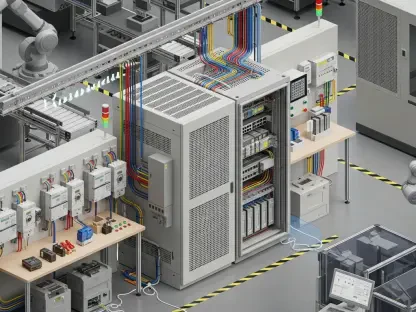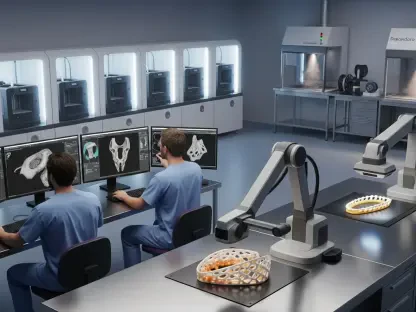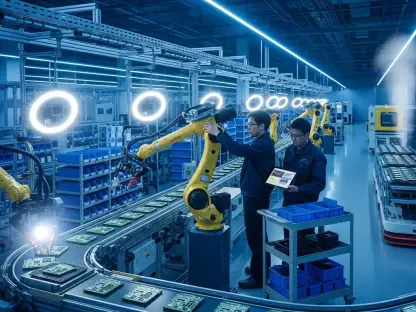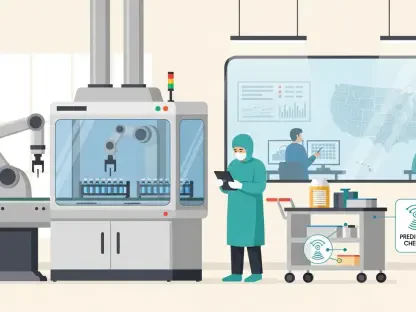The manufacturing sector is experiencing a monumental transformation driven by the rise of digital factories. These advanced facilities leverage digitalization and automation technologies to enhance continuous data flows, providing invaluable insights into every facet of the product and production lifecycle. This paradigm shift enables smarter decision-making, streamlines operations, boosts productivity, minimizes errors, and facilitates real-time monitoring. As digital factories become the new standard rather than the exception, manufacturers must navigate this transition effectively to stay competitive in the rapidly evolving market.
The Promise of Digitalization
Advantages of Digital Factories
Businesses are increasingly recognizing the considerable advantages offered by digital factories. One of the primary benefits includes heightened efficiency. By automating various aspects of production and integrating sophisticated data analytics, manufacturers can optimize workflow processes, thereby reducing the time and resources needed to complete each task. This enhanced efficiency results in faster speed-to-market, allowing companies to meet consumer demand swiftly and more accurately. Moreover, digital factories facilitate data-driven maintenance whereby predictive analytics foresee equipment issues before they become critical, thus minimizing downtime and maintenance costs.
Another significant benefit is the hyper-customization of customer products. Digitalization enables manufacturers to offer tailored solutions that specifically meet individual consumer needs, improving customer satisfaction and loyalty. Furthermore, the seamless integration of real-time data across production lines ensures higher product quality and consistency. Improved data transparency across the supply chain also helps in better decision-making, as managers gain access to precise insights, thus enabling proactive adjustments to the production flow. Ultimately, the transition to digital factories promises to revolutionize traditional manufacturing practices, ensuring businesses remain competitive in a dynamic market environment.
Case Study: A Digitalized Coffee Factory
To illustrate the powerful impacts of digital factories, consider a hypothetical fully digitalized coffee factory. From the procurement of raw kernels to the packaging of the finished product, digitalization touches every stage of production. Initially, advanced quality control mechanisms ensure that only premium beans are selected. Automated bean sorting systems then meticulously classify beans based on size, color, and quality, a process that ensures uniformity in the products. Precision grinding and accurate pod base distribution are accomplished through automated systems, which guarantee consistency and repeatability.
The next step involves dosing and tamping, where automated machines ensure every pod contains the exact quantity of ground coffee. Sealing and packaging processes are similarly optimized to maintain freshness and quality. Real-time visibility into production lines is facilitated by systems such as Supervisory Control and Data Acquisition (SCADA), enhancing productivity and operational efficiency. Moreover, thermal imaging quality control allows the detection of defects early in the production process, ensuring that only compliant capsules proceed to sealing, packing, and market customization. This comprehensive approach demonstrates how digitalization can significantly optimize production quality and operational effectiveness.
Overcoming Challenges
Workforce Transformation
Despite the clear benefits, transitioning to digital factories presents significant challenges, particularly related to workforce transformation. One essential aspect is employee training and talent recruitment. As technology advances, workers must evolve correspondingly, adopting new skills to operate and maintain sophisticated machinery. Upskilling or reskilling programs become indispensable to ensure employees can adapt and thrive in a digitized environment. Additionally, overcoming resistance to change is vital since some employees may be apprehensive about adopting new technologies. Addressing the existing IT talent gap also poses a hurdle, as the industry requires technically proficient personnel to implement and manage digital systems effectively.
Recruitment strategies must focus on attracting individuals with expertise in emerging technologies, such as artificial intelligence (AI), data analytics, and machine learning. Collaborative training programs and partnerships with educational institutions can help bridge the skills gap, ensuring a robust talent pipeline. Equally important is fostering a culture of continuous learning and innovation. Encouraging employees to embrace technological change and providing them with the necessary tools and resources can significantly ease the transition, paving the way for a successful digital factory implementation.
Leadership and Integration
Securing unwavering leadership support stands as another critical challenge. Successful implementation of digital factories demands that management teams be wholly committed and possess a deep understanding of the requirements and challenges involved. It is crucial for leaders to adopt a visionary approach, recognizing where to invest strategically and how to navigate complexities. Effective planning and phased deployment strategies are essential to manage the transition smoothly. Careful integration of new technology components with existing systems is necessary to ensure seamless communication and operational harmony. Legacy infrastructure often presents a significant complication, requiring thoughtful planning to either migrate or effectively integrate new technologies.
Leadership must prioritize clear communication and foster a culture of collaboration across all departments. Ensuring that employees at all levels are informed and engaged in the transition process is vital for overcoming resistance and securing buy-in. Developing a comprehensive roadmap that outlines key milestones, expected outcomes, and potential risks can guide the implementation process. Regular assessments and flexible adjustment strategies will help address unforeseen challenges promptly, ensuring that the transition to a digital factory is both efficient and effective. A strategic and phased approach to deployment will mitigate risks, optimize resource allocation, and maximize the benefits of digitalization.
Data and Budget Management
Data Interpretation and Collaboration
Accurate interpretation and analysis of data derived from industrial equipment form the backbone of informed decision-making within digital factories. To leverage these insights effectively, cross-functional involvement and information transparency are paramount. By ensuring factory floor employees are engaged and actively contributing to the decision-making process, manufacturers can foster a more inclusive and responsive environment. This collaborative approach not only helps in taking timely actions but also enhances overall efficiency and productivity.
Establishing robust data management systems is crucial for facilitating seamless information flow across various departments. Advanced analytics tools can process vast amounts of data, extracting meaningful insights that drive strategic decisions. Emphasizing real-time data sharing and collaboration encourages a culture of transparency, where all stakeholders remain informed and aligned. When employees take ownership of decisions and provide actionable input, the production process becomes more adaptive and resilient. Ultimately, efficient data interpretation combined with proactive collaboration forms the foundation for a successful digital factory transformation.
Financial Considerations
Implementing digital factories necessitates substantial financial investment. Identifying priorities and understanding the long-term impact of digitalization are essential for justifying the budget. Businesses must determine which areas require immediate attention and allocate resources accordingly. Starting with small steps and gradually scaling up allows for effective financial management while achieving the desired transformation outcomes. By focusing on incremental improvements, manufacturers can mitigate risks and manage expenditures prudently.
Careful budgeting strategies should encompass both initial costs and ongoing maintenance expenses. Investing in scalable technologies that can grow with the business is prudent. Additionally, developing a robust financial plan that includes contingency provisions helps address unforeseen challenges without derailing progress. Transparent communication regarding budget allocation ensures all stakeholders are aware of financial commitments and expected returns. Ultimately, meticulous financial planning and prioritization of key investments enable manufacturers to transition to digital factories effectively and sustainably, ensuring long-term success.
Practical Guidance and Cybersecurity
Steps for Digital Transformation
For manufacturers embarking on the journey toward digitalization, practical guidance and strategy are invaluable. Referring to emerging proof points and successful case studies can provide valuable insights into best practices and potential pitfalls. Reducing silos between IT and business departments is critical to maximizing the value of smart manufacturing. Interdepartmental collaboration fosters a unified approach, ensuring coherent implementation of digital systems.
Engaging a partner with end-to-end capabilities in digital integration, connectivity, infrastructure, and applications can significantly ease the transformation process. Such partners bring expertise and tailored solutions, addressing specific business objectives and pain points. Comprehensive evaluations of a company’s existing capabilities and future requirements enable the development of a customized strategy that aligns with overarching goals. Practical steps include establishing clear milestones, conducting regular assessments, and fostering a culture of continuous improvement. By following a strategic roadmap, manufacturers can successfully navigate the complexities of digital transformation and achieve meaningful progress.
Ensuring Security and Compliance
The manufacturing sector is undergoing a profound transformation fueled by the advent of digital factories. These state-of-the-art facilities utilize digitalization and automation technologies to optimize continuous data flows, offering essential insights into every aspect of the product and production lifecycle. This significant shift facilitates smarter decision-making, streamlines operations, increases productivity, reduces errors, and enables real-time monitoring. As digital factories evolve from being an exception to becoming the industry norm, manufacturers must adeptly manage this transition to remain competitive in today’s rapidly changing marketplace. Adopting these new technological advancements isn’t just a trend—it’s a necessity for maintaining an edge in the industry. Companies will need to invest in training, infrastructure, and strategic planning to effectively integrate these innovations. In doing so, they can capitalize on the myriad benefits that digital factories bring, ensuring long-term growth and sustainability.









